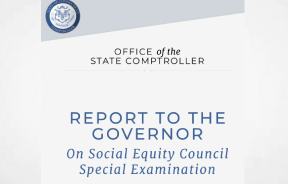Kudos to North Bay Business, the first piece in ages where media asks small and local business what matters to them and the solutions they think the state should try to enact.
You can read the whole article at
https://www.northbaybusinessjournal.com/article/industrynews/cannabis-industry/?ref=recent
Here’s the summing up of the changes the business owners believe is needed
What do you think the state should do to ensure the success of the industry?
Haley Andrew: The state could help by continuing the equity business program that was started in 2023. However, the funds for this program were exhausted in just one year, and the state has yet to replenish them. This program allowed business operators who qualified as equity businesses to receive forgiveness for their license fees for one year and to retain 20% of the cannabis excise tax they collect as retailers. This program is incredibly helpful to the mom-and-pop businesses in the cannabis industry, and it would be beneficial for the state to find the budget to continue it. Cannabis is taxed at 80-90 cents per dollar, whereas tobacco is only taxed at 14 cents and alcohol at 1 cent.
We need our state and local governments to hear us when we say that we are overtaxed. The sales and use tax applied to each cannabis item sold is a compounded tax, meaning your cannabis is triple-taxed each time you make a purchase with a legal operator.
Between the state and local governments, it sometimes feels as if our businesses are treated as a source of income for the government, when in reality, we only want to operate like any other business.
It has been almost eight years since Prop 64 was passed, and the industry has undergone drastic changes during this time. These changes should be evaluated before the next tax increase is implemented. The more we tax this product, the more our customers will turn to the hemp market or return to the illicit market.
Leigh Anne Baker: California must take decisive action to address the challenges facing the cannabis industry. The current regulatory framework imposes prohibitively high costs, with businesses required to pay hundreds of thousands of dollars in licensing fees and navigate a complex and expensive compliance process.
It’s becoming increasingly apparent that the expected financial benefits from these high fees and taxes have not materialized. In fact, regions like Sonoma County and Monterey County are finding that cannabis tax revenue is insufficient to cover the costs of regulating the industry. To create a more sustainable market, the state should reduce licensing fees, simplify the regulatory process, and reassess the tax structure. By making the legal market more accessible and affordable, California can support the growth of cannabis businesses and ensure that communities benefit from a thriving, well-regulated industry.
Sam Hayawi: To ensure the success of the cannabis industry, state governments can take several strategic actions:
1. Tax reform and relief:
— Adjust Tax Rates: California should consider reducing tax rates on cannabis businesses to alleviate the financial burden. High taxes can drive consumers to the black market, undermining legal operators.
— Temporary tax relief: Providing temporary tax relief or tax credits could help struggling businesses stay afloat, especially in the early years of operation.
2. Regulatory streamlining:
— Simplify licensing processes: Streamlining the licensing process and reducing bureaucratic red tape can lower the barrier to entry and allow more businesses to participate in the market.
— Harmonize regulations: Aligning state regulations more closely with federal guidelines (or vice versa) can reduce the complexity and costs associated with compliance.
3. Support for small businesses:
— Access to capital: States could create or expand loan programs specifically for cannabis businesses, helping them access the capital needed for growth and stability.
— Grants and subsidies: Offering grants or subsidies to small or minority-owned cannabis businesses can promote diversity and inclusion within the industry while fostering innovation and competition.
4. Public education and consumer outreach
— Educate consumers: California should invest in public education campaigns to reduce the stigma around cannabis, promote safe consumption, and inform consumers about the benefits of purchasing from legal sources.
— Support for legal markets: By educating consumers about the risks of black-market cannabis, states can help drive traffic to legal dispensaries, thereby supporting legitimate businesses.
5. Interstate commerce preparation
— Plan for federal legalization: States should prepare for the eventuality of federal legalization and interstate commerce by establishing frameworks that allow their cannabis businesses to compete effectively on a national scale.
6. Data-driven policymaking
— Monitor and adjust: States should regularly review the impact of their policies on the industry, using data to make informed adjustments. This could include revisiting zoning laws, improving access to banking, and adapting to market changes.
7. Encourage industry collaboration
— Public-private partnerships: Encourage collaboration between the state and cannabis industry stakeholders to develop policies that support both business growth and public health and safety.
— Industry forums: States could establish regular forums or advisory boards where industry leaders can provide input on regulatory changes and share best practices.
By adopting these strategies, states can create a more sustainable and competitive cannabis industry, ensuring that it thrives as it continues to evolve.
Mat Humphrey: I think the State should do everything in their power to support interstate distribution. Every state would be selling California cannabis. Every consumer in the world wants Cali weed, The state needs to build on the reputation California has as a supplier of world’s best cannabis. Help regulated farms expand legal distribution to other states and eventually worldwide. Like Champagne from France or Cab from Napa. Lean into the reputation built by the pioneers of this great plant.
Eli Melrod: Lowering taxes should be a top priority. The legal market will continue to face issues as long as it’s competing with the untaxed illicit market. Additionally, to help the success of the industry, it would be helpful for the state to collaborate with more municipalities to establish retail ordinances, allowing cannabis to be more widely available to consumers throughout the state.
Julie Mercer-Ingram: Right now it just comes down to the numbers. In general, cannabis businesses are not able to be sustainable in this environment where taxes are extremely high and costs for compliance including license fees are exorbitant. At Proof we’re currently paying over $25,000 per year to the state of California just in license fees.
If you’re a local small business owner: can you imagine paying that every year for your business license? It’s ridiculous. The state and many others thought compliant cannabis was going to be a gold rush, it turns out it’s a business like any other, and if you’re not operating incredibly aggressively and with a lean mentality, you’re not going to survive.
On top of normal business pressures, we are crushed by taxes at every level, from every jurisdiction. The state needs to cut fees and taxes, or there’s not going to be a compliant industry left. That leaves unregulated cannabis, which causes environmental damage, poses risks to public health, offers no tax opportunities to the state, and advances organized crime. Those are really the options — support compliant companies with a normal business environment with normal fees, or let the unregulated market thrive, with all the undesirable things that come along with that. Instead, the state plans to raise taxes on compliant cannabis next year, which will cause many more closures.
Angelica Sanchez: The state must reconsider its excise tax, currently at 15%, which will likely increase to 19% in 2025. Small businesses can’t sustain a 30% tax on retail goods, and cannabis businesses are no exception. The cumulative tax on cannabis products in California ranges from 30-40%, including the state excise tax, local cannabis tax and sales tax. These taxes are compounded, with customers effectively paying tax on top of tax at checkout, driving up the cost of legal cannabis. Reducing these rates is essential to keeping legal products affordable and encouraging consumers to choose regulated options over the illicit market. Lowering taxes would strengthen the legal market, increase long-term tax revenue, and help curb the pervasive black market.
Laurel Washburn: They need to lower tax rates and realize our industry has more in common with potato farmers than pharmaceutical labs. We aren’t a designer drug, we are the people’s choice; respect that we can’t bring in big pharma money and can’t be taxed the same way. We need to spend less time nitpicking little policies such as more QR codes on the already overcrowded/over regulated packaging and more time on fair banking, tax relief, and protections for legal businesses.
Also read on to read their opinions on Hemp vs Cannabis and the recent Newsom legislation
https://www.northbaybusinessjournal.com/article/industrynews/cannabis-industry/?ref=recent

















